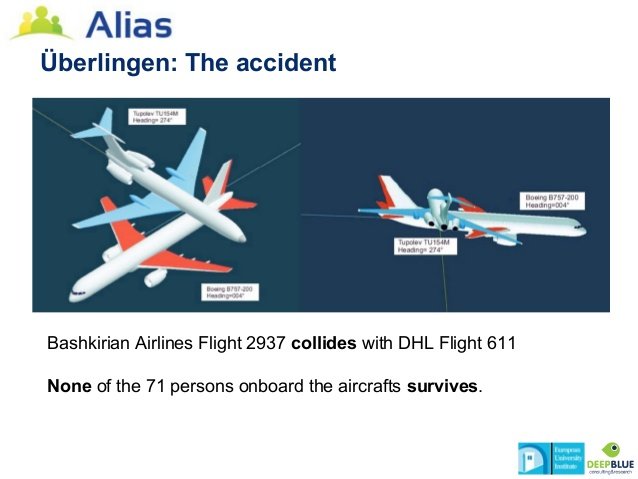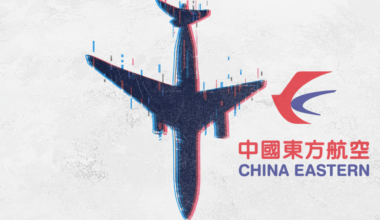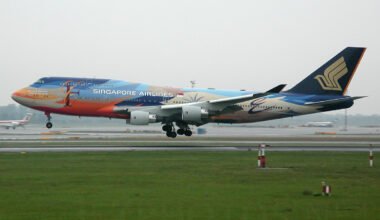Brief Description of the Mid-Air Disaster
The occurrence took place on the night of 1 July 2002. Bashkirian Airlines Flight 2937, and DHL Flight 611 had a mid-air disaster in mid-air over Uberlingen. A place situated in the south of the German town of Lake Constance near the Swiss border. All 69 passengers and crew aboard the Tupolev and both crew members of the Boeing were killed.
Aircraft Involved in the Accident
Details of the First Aircraft
- Date: 01 July 2002
- Time: 23:35
- Type: Boeing 757-23APF
- Operator: DHL Aviation
- Registration: A9C-DH
- Fatalities: 2 of 2 crew, no passengers
- Aircraft Fate: Destroyed
- Phase: En route
- Airports: (Departure) Bergamo-Orio Al Serio Airport (BGY/LIME), Italy; (Destination) Brussel-Zaventem Airport (BRU/EBBR), Belgium

Details of the Second Aircraft
- Type: Tupolev 154M
- Operator: Bashkirskie Avialinii
- Registration: RA-85816
- Fatalities: 9 of 9 crew, 60 of 60 passengers
- Aircraft Fate: Destroyed
- Phase: En route
- Airports: (Departure) Moskva-Domodedovo Airport (DME/UUDD), Russia; (Destination) Barcelona Airport (BCN/LEBL), Spain

Details of the Investigation
German Federal Bureau of Aircraft Accident Investigation conducted the investigation of the occurrence as the debris of both aircraft had fallen in Germany. International Civil Aviation Organization (ICAO) spells out the same rule in Annexure 13 for designating the responsibility of conducting an investigation.
The bureau was able to track the Flight Data Recorder (FDR) of DHL-611 from the wreckage site. The FDR showed the collision of the two aircraft while flying on the same course but converging from different directions.

TU-154M was a passenger aircraft whereas, Boeing 757 was a cargo aircraft. Both aircraft were flying at flight level FL360 (which means 36,000 feet above sea level). While changing the Flight Information Region (FIR), communications were handed over from Munich to Zürich ACC at 23:30:11.
At that moment, one controller was responsible for the entire traffic in the Zürich airspace. He was monitoring two frequencies and two radar scopes. On one frequency (119,925 MHz), he was guiding one traffic for an approach into Friedrichshafen, and on the other frequency (128,050 MHz), he had to control four aircraft.
Among these four aircraft were Bashkirian 2937 and a DHL Boeing 757 cargo plane (DHL 611) en route from Bergamo (BGY), Italy, to Brussel (BRU), Belgium, along RNAV-Route ABESI-AKABI-TANGO, also at FL360.
Role of Traffic Collision Avoidance System (TCAS) and Conflicting Instructions from Zurich, ATC
At 23:42:56, both aircraft crews received a Resolution Advisory (RA)-command from their TCAS. The DHL crew complied with this and initiated a descent. Simultaneously, the Tupolev crew were trying to deal with the conflicting descent (by ATC) and climb (TCAS) instructions.
Seven seconds after the Resolution Advisory command, the ATC controller repeated the instruction to descend. The Bashkirian crew then decided to follow the ATC controller’s instructions. A little later, the TCAS aboard the Boeing 757 gave the crew a Resolution Advisory to “increase descent.”
They then contacted ATC, reporting that they were making a TCAS descent. Since both aircraft were descending, the Russian plane’s TCAS warned the crew to “increase climb” to avoid a collision. This was eight seconds before the collision. Before the collision, both crews detected the other aircraft and reacted to avoid the collision by attempting appropriate flight maneuvers.
The Fate of the Two Aircraft; Mid-Air Disaster
At 23:35:32 both aircraft collided at approx. FL354 (means 35,400 feet). The tail fin of the Boeing 757 struck the left side of the Tupolev 154 fuselage near both overwing emergency exits, while the Tupolev’s left wing sheared off 80% of the Boeing’s tail fin. The Tupolev immediately broke up into four pieces (left wing, right-wing, main fuselage, and tail unit including the engines). The Boeing 757 lost entire control due to the missing vertical tail fin and crashed 8 km north of the Tupelov, just after losing both engines.
What Went Wrong?
That night, from 23:00, the configuration of the radar data processing of Skyguide (Communication System) was modified. Thus the system was operating in FALLBACK mode. This requires, among other facts, that radar separation values were increased from 5 NM to 7 NM. Also, the STCA (Short-Term Conflict Alert) was not available at that time. From 23:33:36 the controller of Karlsruhe UAC tried in vain to get in contact with Zürich-ATC until 23:35:34. Between 23:33:36 and 23:34:45, the busy signal was to be heard the ringing tone afterward. According to the statements, the controller repeatedly tried to establish the connection via the priority button, but it failed.
Root Cause of the Occurrence
The main cause of the collision is several shortcomings on the part of the Swiss Air Traffic Controller (ATC) service in charge of the sector involved and ambiguities in the procedures regarding the use of the onboard Traffic Collision Avoidance System (TCAS).
Taking a Step back
A year and a half before this midair, on 31 January 2001, two Japan Airlines Boeing 747s nearly collided over Japan in nearly identical circumstances. Both aircraft received proper TCAS resolution alerts, but a trainee air traffic controller gave one of the planes conflicting instructions. The pilots spotted each other and managed to avoid collision by only 35 feet. Nine passengers and two crew were seriously injured during the violent evasive maneuvering. The Japanese government asked the ICAO for guidance. ICAO decided to leave the rules up to individual governments.
Analysis
Analysis of the accident teaches a few very important lessons.
- The absence of standard procedures by ICAO caused an earlier occurrence of a similar nature. The occurrence under discussion was the second one of this nature; however, this time, it did not spare precious lives. Had ICAO taken a firm stance and decision after the first occurrence, much confusion would have been cleared among the operators.
- One operator (DHL-611) followed the TCAS as per their defined procedures despite repeated warnings from the Zurich Air Traffic Controller. The other operator (TU-154M) disregarded the TCAS warning and listened to the controller. At this stage, a clear confusion seems to be occurring at the end of both operators. Why? Because ICAO had left the decision-making in such a scenario to the discretion of governments. This indicates a lack of standardization in rules.
- In the aviation environment, much of the working principle works on standardization. Discretions have only been allowed where no instruction is available to manage a particular situation.
- The systems and procedures have become quite robust in all these years. There is hardly anything that is not available on books for seeking guidance in case of emergencies.
- The occurrence is also attributed to negligence since the Zurich Air Traffic Control had only one controller who managed the traffic on two radar scopes with a delayed and incomplete picture. This shows inappropriate workload management. Similarly, the communication system was inappropriate to communicate the situation on time due to the system’s maintenance at night time; programmed because of lesser traffic at night time.
- With only one controller on the job, equipped with incomplete resources as a result of technical maintenance, a major compromise was made against the lives of innocent people—a sheer case of negligence.
Lessons Learnt
There should be standard procedures for all the operators. The operators must be trained to follow the onboard warning system for their own safety. These systems are highly reliable, and they have saved thousands of lives. Similarly, air traffic controllers have a serious responsibility on their shoulders. Their systems must be updated and active mode at all times, or else backups must be available to manage any untoward situation in the air.
Written by guest writer, Faisal Bashir



